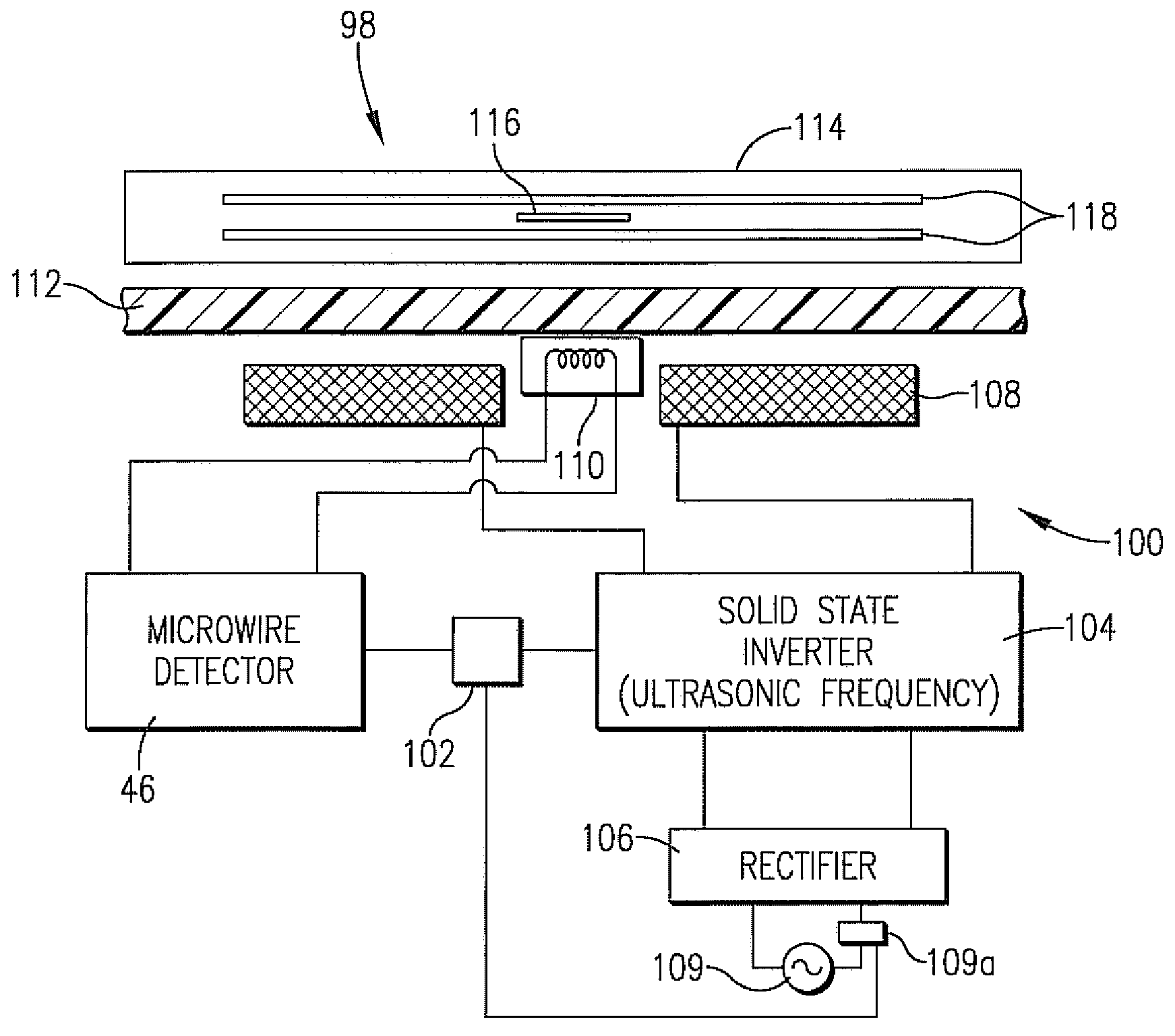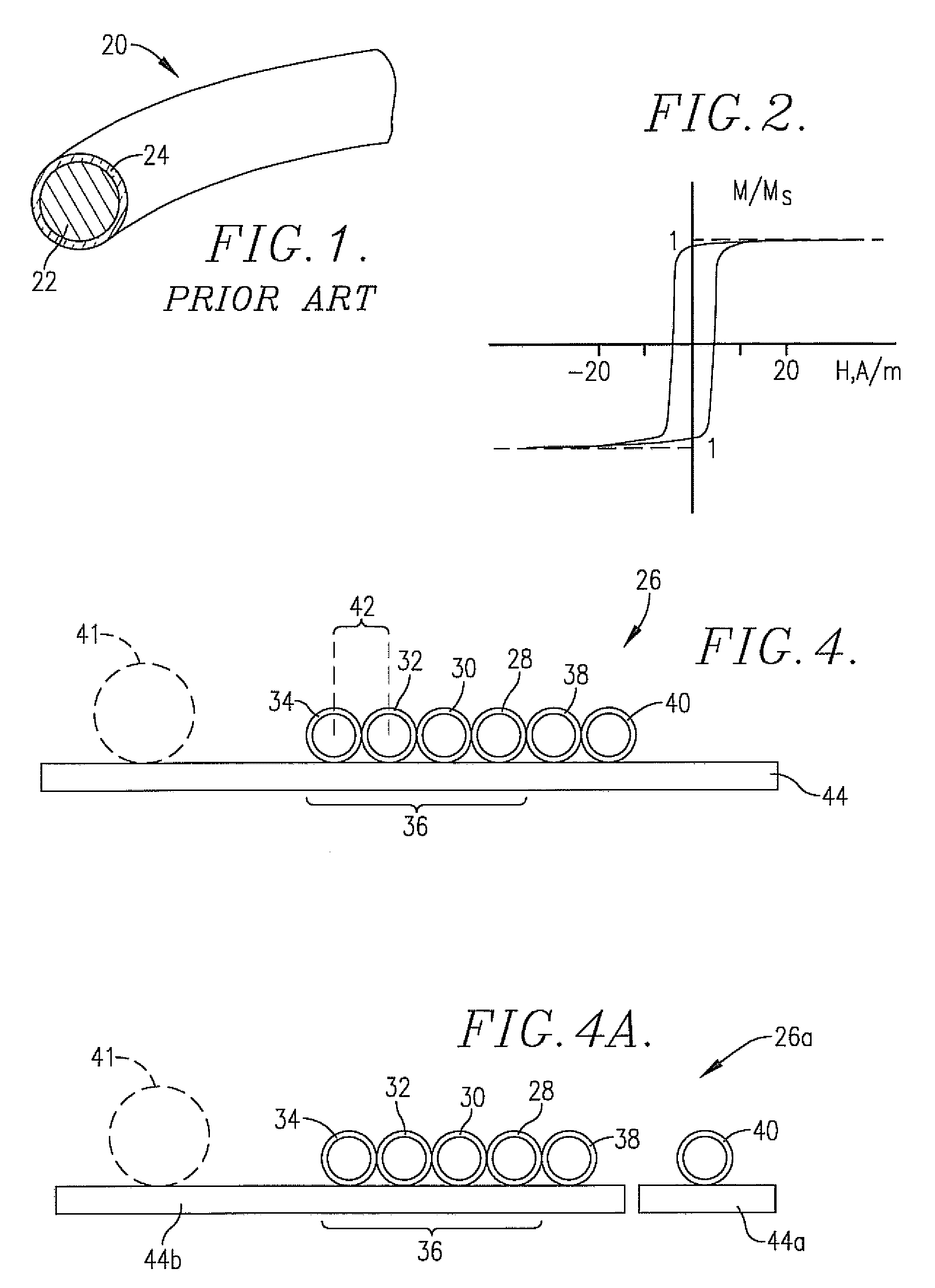Magnetic element temperature sensors
a technology of temperature sensors and magnetic elements, applied in the direction of instruments, electric/magnetic/electromagnetic heating, heat measurement, etc., can solve the problem of not completely eliminating the detectable re-magnetization pulse, etc., and achieve the effect of reliable temperature sensing and readily monitored
- Summary
- Abstract
- Description
- Claims
- Application Information
AI Technical Summary
Benefits of technology
Problems solved by technology
Method used
Image
Examples
first embodiment
Modified Chemistry Microwires for Curie Temperature Sensing
[0050]The first embodiment of the invention comprises a magnetic microwire temperature sensor having at least one and usually a plurality of magnetically susceptible microwires, with the individual alloys of at least certain of the microwires having modified chemistries and consequent different Curie temperatures, usually below about 400° C. Additionally, this embodiment includes a microwire reader or detector capable of decoding temperature information derived from the sensor microwires.
[0051]Chemically modified individual microwires are preferably fabricated so that the modified microwires retain large Barkhausen discontinuities, extremely low coercivities, and extremely high permeabilities below their respective Curie temperatures (with resultant hysteresis behavior of the type depicted in FIG. 2). These modified microwires essentially completely lose their ferromagnetism above their Curie temperatures. Other microwires w...
second embodiment
Microwires with Ferromagnetic Sheaths for Temperature Sensing
[0068]This second embodiment comprises a magnetic element temperature sensor 64 having a plurality of composite temperature-sensing microwires 66 each including a magnetically susceptible microwire of the prior art type described above that has no intentional reduction of its Curie temperature, such that it will retain its large Barkhausen discontinuity and other magnetic properties as depicted in FIG. 2 throughout the entire operating range of the sensor 64. This microwire structure further includes a surrounding, tubular, structure 68. The overall second embodiment further includes a microwire temperature detector similar to detector 46 having stored algorithm(s) capable of decoding the temperature information derived from interrogation of the sensor 64.
[0069]In particular, each of the composite microwires 66 has an innermost alloy 70 surrounded by an intermediate glass coating 72, such that this inner portions of the co...
third embodiment
Microwires with Seperate but Adjacent Ferromagnetic Saturation Elements for Temperature Sensing
[0086]The third embodiment is conceptually very similar to the second embodiment and differs in the use of ferromagnetic sheath saturation or biasing elements as separate entities which do not need to touch the surface of the adjacent temperature-sensing microwires, as compared with the sheaths 74 of the second embodiment which are bonded or otherwise affixed to central microwire structure. Referring to FIG. 7, a combination microwire 92 is illustrated and includes a microwire 20 of the type previously described that has no intentional reduction of its Curie temperature, such that it will retain its large Barkhausen discontinuity and other magnetic properties as depicted in FIG. 2 throughout the entire operating range of the sensor. Also, the combination microwire 92 includes an adjacent ferromagnetic sheath 94. The sheath 94 is located near enough to the associated microwire 20 so as to p...
PUM
 Login to View More
Login to View More Abstract
Description
Claims
Application Information
 Login to View More
Login to View More - R&D
- Intellectual Property
- Life Sciences
- Materials
- Tech Scout
- Unparalleled Data Quality
- Higher Quality Content
- 60% Fewer Hallucinations
Browse by: Latest US Patents, China's latest patents, Technical Efficacy Thesaurus, Application Domain, Technology Topic, Popular Technical Reports.
© 2025 PatSnap. All rights reserved.Legal|Privacy policy|Modern Slavery Act Transparency Statement|Sitemap|About US| Contact US: help@patsnap.com



